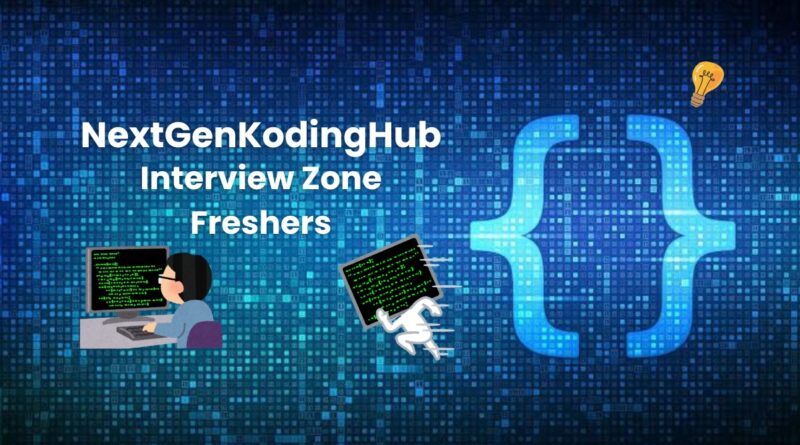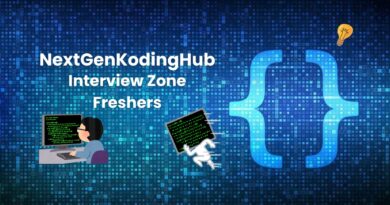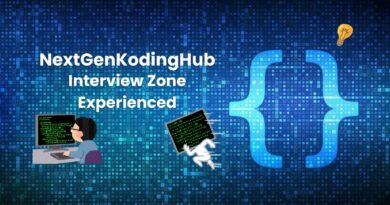Full Stack Interview Prep (Fresher)
Interview Zone: Full Stack Interview Preparation
Top 30+ Full Stack Interview Prep for Freshers
If you’re aiming to launch a career in full stack development, then mastering full stack interview prep for freshers is essential. Moreover, this guide provides more than 30 widely asked questions across frontend, backend, databases, APIs, and DevOps, categorized into easy, medium, and advanced levels. As you work through this list, your understanding of web architecture will grow significantly, boosting both your skills and confidence.
Easy Full Stack Interview Prep for Freshers
1. What does “full stack” mean?
A full stack developer handles both frontend (client-side) and backend (server-side) development, plus databases. Therefore, they build complete web applications from the user interface to server logic.
2. Name some frontend technologies you use.
Developers often use HTML, CSS, and JavaScript for frontend development. Frameworks like React, Angular, or Vue help create dynamic user interfaces.
3. What is the Document Object Model (DOM)?
The DOM represents HTML as a tree structure. JavaScript and frameworks manipulate the DOM to update the page dynamically based on user actions.
4. What is CSS, and why do we use it?
CSS controls the presentation of webpages—like layout, colors, and fonts. It separates style from structure, making design scalable and reusable.
5. What are frontend frameworks, and name one you’ve used.
Frontend frameworks speed up UI development by providing reusable components and routing tools. For example, React simplifies building interactive interfaces.
6. What is responsive design?
Responsive design ensures webpages adapt to different device sizes. Developers use fluid layouts and media queries to ensure usability across screens.
7. Name some backend technologies you use.
Backend developers often work with Node.js, Python (Django/Flask), Java (Spring), or PHP. Here, they handle server logic, databases, and APIs.
8. What is an API?
An API (Application Programming Interface) allows different software systems to communicate. Full stack developers use REST or GraphQL APIs to connect frontend and backend.
9. What is SQL versus NoSQL?
SQL databases (like MySQL and PostgreSQL) store structured, relational data. NoSQL systems (like MongoDB) handle unstructured or flexible schemas.
10. Explain the request-response cycle.
The browser sends a request to the server, which processes it and responds with HTML, JSON, or error codes for the frontend to display.
Medium Full Stack Interview Prep for Freshers
11. What is RESTful architecture?
RESTful APIs follow REST principles—statelessness, resource-based routes, and using HTTP verbs. Full stack developers design, consume, and document these APIs.
12. What is JSON, and why is it important?
JSON (JavaScript Object Notation) is a data format for sending structured data between frontend and backend. It’s both human-readable and easy to parse.
13. What is session versus token-based authentication?
Sessions store login state on the server, while tokens (like JWT) carry authentication state in the client’s requests—often stateless and scalable.
14. What are environment variables?
Environment variables store sensitive settings like API keys or DB credentials outside the codebase—making it safer and easier to configure across environments.
15. What is CORS?
CORS (Cross-Origin Resource Sharing) controls which domains can access your APIs. Developers configure headers on server responses to allow frontend access.
16. What is AJAX or fetch?
AJAX and fetch let the frontend request data from the backend asynchronously. This enables updating page details without reloading the entire page.
17. What is an ORM, and name one.
ORM (Object-Relational Mapping) lets developers interact with the database via objects instead of SQL. Examples include Sequelize (Node.js) or SQLAlchemy (Python).
18. What is version control?
Version control systems like Git track code changes and support branching. This makes collaboration efficient and risk-free.
19. How do you handle form validation?
You can validate forms on the client-side for quick feedback and on the server-side for security—never relying solely on one layer.
20. What is responsive deployment?
Developers deploy across staging and production environments. Using CI/CD pipelines guarantees that code pushes deploy automated tests and builds.
Advanced Interview Questions for Freshers
21. What is component-based architecture?
Component-based architecture builds UIs with reusable parts. Full stack developers design both UI and API around shared components for consistency.
22. What are service workers?
Service workers act as background scripts in browsers, enabling offline caching and push notifications for progressive web apps (PWAs).
23. What is microservices architecture?
Microservices split an application into small, independent modules. Developers deploy the frontend and backend as separate services that communicate via APIs.
24. What are web sockets?
WebSockets provide full-duplex, real-time communication between frontend and backend—ideal for live chats and real-time notifications.
25. What is DevOps, and how does it support full stack?
DevOps integrates development and operations for fast and reliable deployments. Full stack developers work with Docker, CI/CD, monitoring, and cloud platforms like AWS or Azure.
26. What is containerization?
Containerization packages apps and dependencies into isolated environments. Full stack developers use Docker to ensure consistency across environments.
27. Explain caching strategies.
Caching stores frequently used data in memory or CDN. Developers use browser caches, Redis, or Varnish to reduce DB hits and speed up load times.
28. How do you ensure security?
Security involves input validation, HTTPS implementation, JWT usage, CSRF protection, and sanitizing inputs to prevent SQL injection and XSS attacks.
29. What is an API gateway?
API gateways serve as a single entry point for microservices—they manage routing, rate limiting, authentication, and analytics.
30. What is performance monitoring?
Developers monitor performance using tools like New Relic, Prometheus, or Grafana. They track metrics like latency, error rates, and uptime to optimize systems.
31. How do you handle concurrency?
Use async programming, worker queues, locks, or optimistic concurrency control to prevent race conditions and ensure data consistency.
32. What is serverless architecture?
Serverless platforms like AWS Lambda let developers run backend code without managing servers—simplifying scaling and reducing costs.
Conclusion:
In conclusion, this full stack interview prep for freshers guide covers a broad spectrum of core and advanced topics—from frontend and backend basics to DevOps and security. By practicing these 30+ questions and building projects across the stack, you’ll improve your skills, clarity, and confidence when facing interviews.



